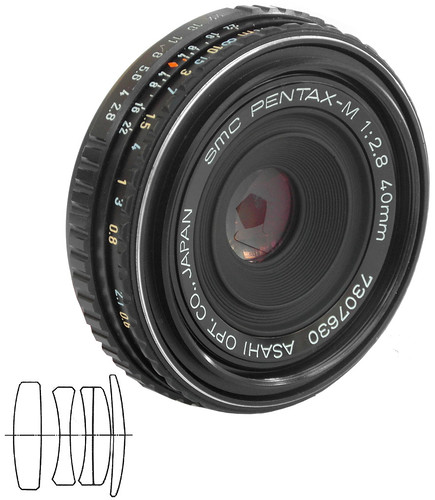Difference between revisions of "Pancake lens"
(A stab at Pancake definition) |
m (Added the tiny Canon EFS24mm to the list and Pentax 40mm new version (2022)) |
||
| Line 13: | Line 13: | ||
The trend for pancake lenses blossomed in the 1970s among 35mm film [[SLR]]s.<ref>A particularly tiny 38mm f/2.8 normal lens was briefly offered for the [[Olympus Pen F | Olympus Pen half-frame system]], and there may be other claimants to the title of “the first pancake.”</ref> In contrast to [[rangefinder camera]]s (or indeed, to 2020s [[MILC | digital mirrorless]] models) the clearance for an SLR’s [[Reflex finder | flipping reflex mirror]] necessitates a longer [[flange focal distance]] and a greater body depth. In these systems, wide-angle focal lengths require a [[retrofocus]] design which typically makes them physically larger than the system’s normal lenses. | The trend for pancake lenses blossomed in the 1970s among 35mm film [[SLR]]s.<ref>A particularly tiny 38mm f/2.8 normal lens was briefly offered for the [[Olympus Pen F | Olympus Pen half-frame system]], and there may be other claimants to the title of “the first pancake.”</ref> In contrast to [[rangefinder camera]]s (or indeed, to 2020s [[MILC | digital mirrorless]] models) the clearance for an SLR’s [[Reflex finder | flipping reflex mirror]] necessitates a longer [[flange focal distance]] and a greater body depth. In these systems, wide-angle focal lengths require a [[retrofocus]] design which typically makes them physically larger than the system’s normal lenses. | ||
| − | But following the trend towards more compact SLRs launched by the [[Olympus_OM-1/2/3/4#OM-1_.28M-1.29 | Olympus OM-1]], 1970s camera manufacturers attacked the problem of minimizing SLR lens size as well. Optically, the sweet spot for the smallest-possible SLR lens is typically a focal length just slightly wider than the 50mm “standard.” One particularly striking example is the Pentax-M 40mm f/2.8 from 1976, which reduced the barrel length to its shortest practical minimum while still allowing room for grasping its focus and aperture rings. | + | But following the trend towards more compact SLRs launched by the [[Olympus_OM-1/2/3/4#OM-1_.28M-1.29 | Olympus OM-1]], 1970s camera manufacturers attacked the problem of minimizing SLR lens size as well. Optically, the sweet spot for the smallest-possible SLR lens is typically a focal length just slightly wider than the 50mm “standard.” One particularly striking example is the Pentax-M 40mm f/2.8 from 1976, which reduced the barrel length to its shortest practical minimum while still allowing room for grasping its focus and aperture rings. [[Pentax]] had success in the sales of this lens, to the point that is still available today, under the SMCP-DA 40mm f/2.8 ED name in 2022. |
| − | Pancakes of 40 or 45mm for film SLR systems were introduced by many makers, such as [[Minolta]], [[Chinon]], [[Olympus]], [[Konica]], and [[Nikon]]. The concept lives on in lenses for modern digital cameras, for example the Fujifilm XF 27mm f/2.8, | + | Pancakes of 40 or 45mm for film SLR systems were introduced by many makers, such as [[Minolta]], [[Chinon]], [[Olympus]], [[Konica]], and [[Nikon]]. The concept lives on in lenses for modern digital cameras, for example the Fujifilm XF 27mm f/2.8, Canon EF-M 22mm f/2, or Canon EF-S 24mm f/2.8 STM. |
==Notes== | ==Notes== | ||
<references/> | <references/> | ||
Revision as of 12:28, 29 January 2022

|
| Pentax-M pancake and its optical design image by Alf Sigaro (Image rights) |
Within any interchangeable-lens system, models informally dubbed “pancake” refer to lenses notable for their short barrel length—shorter than their diameter—as if flattened like a pancake against the camera’s lens mount.
Such lenses frequently sacrifice maximum aperture in the interest of compactness. This trade-off may be desirable for situations such as travel or street photography; or whenever the user prefers to stash their camera safely underneath a jacket or inside one of its pockets.
The trend for pancake lenses blossomed in the 1970s among 35mm film SLRs.[1] In contrast to rangefinder cameras (or indeed, to 2020s digital mirrorless models) the clearance for an SLR’s flipping reflex mirror necessitates a longer flange focal distance and a greater body depth. In these systems, wide-angle focal lengths require a retrofocus design which typically makes them physically larger than the system’s normal lenses.
But following the trend towards more compact SLRs launched by the Olympus OM-1, 1970s camera manufacturers attacked the problem of minimizing SLR lens size as well. Optically, the sweet spot for the smallest-possible SLR lens is typically a focal length just slightly wider than the 50mm “standard.” One particularly striking example is the Pentax-M 40mm f/2.8 from 1976, which reduced the barrel length to its shortest practical minimum while still allowing room for grasping its focus and aperture rings. Pentax had success in the sales of this lens, to the point that is still available today, under the SMCP-DA 40mm f/2.8 ED name in 2022.
Pancakes of 40 or 45mm for film SLR systems were introduced by many makers, such as Minolta, Chinon, Olympus, Konica, and Nikon. The concept lives on in lenses for modern digital cameras, for example the Fujifilm XF 27mm f/2.8, Canon EF-M 22mm f/2, or Canon EF-S 24mm f/2.8 STM.
Notes
- ↑ A particularly tiny 38mm f/2.8 normal lens was briefly offered for the Olympus Pen half-frame system, and there may be other claimants to the title of “the first pancake.”